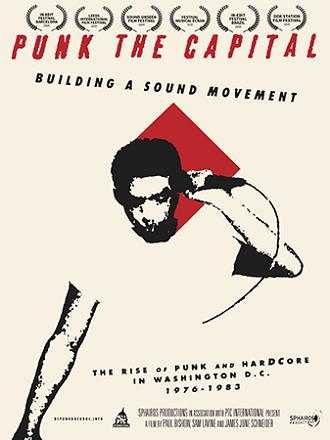
Punk the Capital: Building a Sound Movement 2019
Distributed by Passion River Films, 154 Mt. Bethel Rd., Warren, NJ 07059; 732-321-0711
Produced by James June Schneider
Directed by Paul Bishow and James June Schneider
Streaming, 88 mins
High School - General Adult
Music; Punk rock music
Date Entered: 08/27/2021
Reviewed by Timothy Hackman, University of Maryland Baltimore CountyPunk the Capital: Building a Sound Movement tells the story of the punk scene in Washington, DC between 1976 and 1983. It traces the development of the music and its audience through interviews with musicians, fans, disc jockeys, and journalists, interspersed with some truly outstanding footage of the punk scene in its heyday. It also does an admirable job of placing the movement in the larger context of national politics and of Washington, DC, a conservative “office town” no matter which party was in power. Survivors of the punk scene as well as current District residents will appreciate the footage of DC record stores, streets, and long-ago-demolished venues from the late 70s and early 80s.
The story begins in 1976, when bands like The Slickee Boys and Overkill brought their ragtag sound to venues like The Keg, a divey metal bar slash strip club in the DC neighborhood of Glover Park. Randy Austin of Overkill provides the soundbite that sums up the entirety of the punk movement: “We dared to suck. We weren’t afraid to be horrible in our eagerness to be something.” From there the punk sound moved out to venues both conventional and unconventional, including high schools, basements, and abandoned buildings. Like the music itself the film moves along at a brisk pace, offering up segments on the major bands -- Bad Brains, Teen Idles, SOA/Black Flag, Minor Threat (“Finally we have our Beatles” remarked one fan upon seeing the latter band) -- as well as elements of punk culture including fanzines, slam dancing, tension between punks and hippies, the “Straight Edge” subculture which eschewed alcohol and drugs, and the eventual infiltration of white supremacist Skinheads that led to the scene’s decline. The filmmakers claim to have collected more than 100 interviews for the film, and there is certainly an impressive array of interview subjects and commentators. These interviews include well-known names like Henry Rollins (SOA/Black Flag), Ian MacKaye (Teen Idles, Minor Threat), and NPR host Bob Boilen, as well as less- or never-famous names from bands long forgotten and former scenesters; taken together they round out the picture of punk in the nation’s capital.
As informative as the interviews are, the musical footage is the main attraction here. The sound is rough and raw, the crowds frenzied, and the musicians occasionally only barely competent but always totally committed. Handwritten titles cards with song and artist names that look like they were torn from a fanzine helpfully accompany each performance clip, although it would be nice to know the venue and approximate date of each performance, too. Bands like Black Market Baby, White Boy, Chumps, Untouchables, Tru Fax and the Insaniacs, Void, Half Japanese, Government Issue, DOA, Faith, The Nurses, Youth Brigade, Overkill, The Razz, Penetrators, Young Turds, Da Moronics, Rites of Spring, and The Enzymes all come and go in the film’s 90 minutes, as they did in six years in real life. Overall this film is recommended for fans of popular music and culture, punk and its related musical movements (hardcore, garage, skate punk, and more), and students of 70’s and 80s social history.
Published and licensed under the Creative Commons Attribution 4.0 license. Anyone can use these reviews, so long as they comply with the terms of the license.
Subject